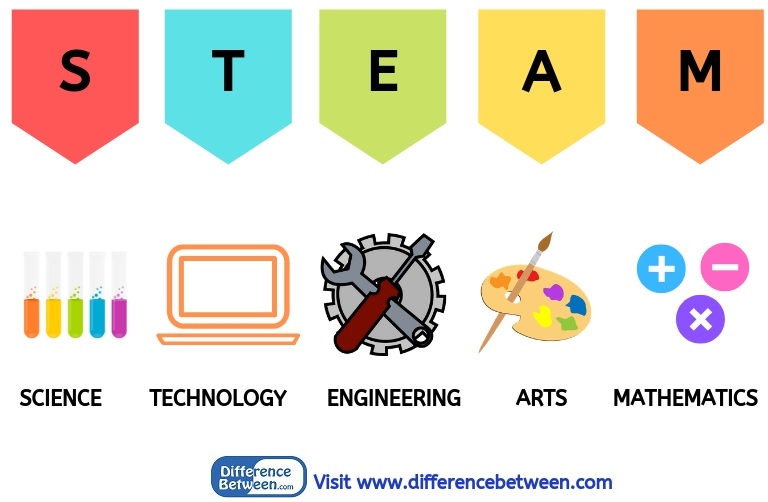The key difference between STEM and STEAM is that STEM is an educational approach that integrates Science, Technology, Engineering and Mathematics whereas STEAM is an educational approach that integrates Science, Technology, Engineering, Arts, and Mathematics. While both approaches aim to provide students with different ways of learning and problem-solving, STEM focuses on the connections between science, technology, engineering, and mathematics, while STEAM incorporates creative thinking and applied arts in real-world situations.
Key Takeaways
- STEM stands for Science, Technology, Engineering, and Mathematics, while STEAM stands for Science, Technology, Engineering, Arts, and Mathematics.
- STEM focuses on the connections between its four areas, while STEAM incorporates creative thinking and applied arts in real-world situations.
- STEAM addresses the major drawback of STEM by including arts, thus promoting a more well-rounded education.
What is STEM?
STEM is an abbreviation that stands for Science, Technology, Engineering, and Mathematics. It is an innovative approach to learning and development that integrates the areas of science, technology, engineering, and mathematics. Moreover, this integration is a cohesive learning model which is based on real-world applications. For many years, students learned science, technology, engineering and mathematics as four separate subjects at school. However, STEM places more emphasis on the connections between these four areas. If we look at a real-world example, science relies on technology, engineering, and mathematics. Likewise, engineering depends on scientific findings, application of mathematics and the use of technology.
STEM-based learning programs can span from preschool through masters-degree programs and are now available in many countries, not just in the US. Furthermore, the basic aims of STEM are to provide students with the chance to experience different ways of learning and problem-solving and to increase their interest in pursuing higher education and careers in the fields of science, technology, engineering, and mathematics. Although there are many advantages to STEM, it has one major drawback. It is the lack of focus on other areas such as literature, art, music, and writing. Moreover, what students learn from these subjects help their brain development, communication skills, and critical reading skills.
What is STEAM?
STEAM is a solution to the major drawback of STEM. It is an educational approach that integrates Science, Technology, Engineering, Arts, and Mathematics. It makes use of basic STEM principles and integrates them in and through the arts. Moreover, it incorporates creative thinking and applied arts in real situations. Additionally, some people feel that adding arts to STEM is not very useful as the main aim of STEM is to encourage students to pursue higher education and career in the fields of science, mathematics, technology, and engineering. However, arts is not only about painting or working in a studio, but it is about discovering and creating novel ways of problem-solving. Furthermore, Georgette Yakman, a founder of the STEAM initiative, describes STEAM as “Science and Technology, interpreted through Engineering and the Arts, all based in elements of Mathematics.”
What is the Difference Between STEM and STEAM?
The key difference between STEM and STEAM is that STEM is an educational approach that integrates Science, Technology, Engineering, and Mathematics while STEAM is an educational approach that integrates Science, Technology, Engineering, Arts, and Mathematics. STEM does not focus on other areas such as arts, music, and writing. However, STEAM incorporates art with STEM. So, we can consider this as another difference between STEM and STEAM.
Summary – STEM vs STEAM
STEM stands for Science, Technology, Engineering, and Mathematics whereas STEAM stands for Science, Technology, Engineering, Arts, and Mathematics. The key difference between STEM and STEAM is that STEAM focuses on arts whereas STEM does not.
